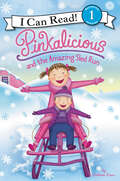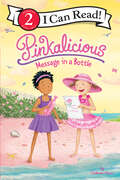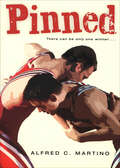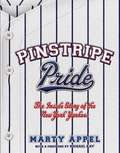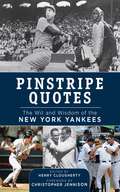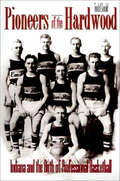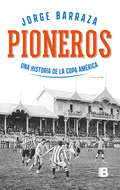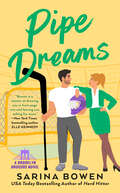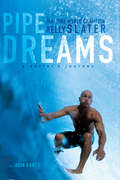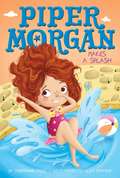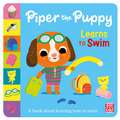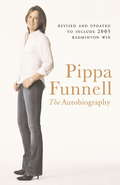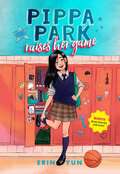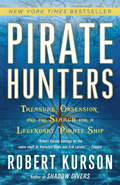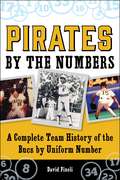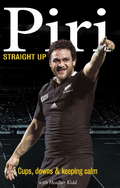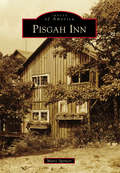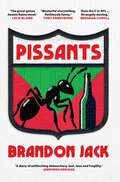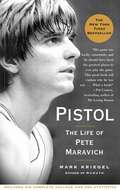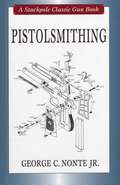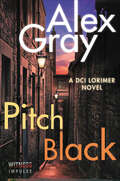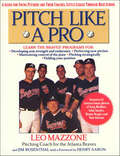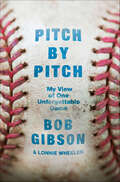- Table View
- List View
Ping-Pong Shabbat: The True Story of Champion Estee Ackerman
by Ann D. KoffskyPOP POP KERPOW!Eleven-year-old Ping-Pong phenom Estee Ackerman must make a difficult choice. When her championship match is scheduled on the Jewish Sabbath, will she go for the gold medal, or honor her faith? Read the true story of how a young girl struggled to uphold her beliefs while pursuing her passion.Tournament after tournament, Estee kept winning.She beat all sorts of players. Some were older. Some were younger. She even beat tennis star Rafael Nadal! She became one of the best Ping-Pong players in the United States.Estee Ackerman loved Ping-Pong more than anything. But she also loved and honored the Jewish tradition of the Sabbath. At age eleven, she began to rise in the ranks of tournament players, making it all the way to the finals of the US National Table Tennis Championships. She only had one player left to beat to win a gold medal--but the final match was set during Shabbat, and the judges said they couldn't change it. How could Estee choose between her passion and her faith? This is the true story of a girl's struggle between her love for her religion and her love of the game.
Pinkalicious and the Amazing Sled Run (I Can Read Level 1)
by Victoria KannReaders can watch Pinkalicious and Peterrific on the funtastic PBS Kids TV series Pinkalicious & Peterrific!#1 New York Times bestselling author Victoria Kann brings young readers a Pinkalicious I Can Read adventure about imagination, courage, and lots of snow! Pinkawow! It snows so hard in Pinkville that the snow reaches the rooftops. Pinkalicious and Peter build a sled run that starts at Pinkalicious’s upstairs bedroom window and goes all over Pinkville! Wheeee!When Peter sees how steep it is he freezes in his tracks! Can his big sister Pinkalicious help Peter conquer his fears and enjoy the ride?Pinkalicious and the Amazing Sled Run is a Level One I Can Read book, which means it’s perfect for children learning to sound out words and sentences.
Pinkalicious: Message in a Bottle (I Can Read Level 2)
by Victoria KannPinkalicious and and her friend Molly visit the beach and discover a riddle to solve. When Pinkalicious and Molly find a message in a bottle, the riddle inside sends them on a pinkatastic adventure! Will the pinktectives solve the mystery?From #1 New York Times bestselling author Victoria Kann, Pinkalicious Message in a Bottle is is the first ever Level 2 Pinkalicious story!Level Two I Can Read books are geared for kids who read on their own but still need a little help. Whether shared at home or in a classroom, the engaging stories, longer sentences, and language play of Level Two books are proven to help kids take their next steps toward reading success.Plus readers can watch Pinkalicious and Peter on the funtastic PBS Kids TV series Pinkalicious & Peterrific!
Pinned
by Alfred C. MartinoIvan Korske and Bobby Zane couldn't be more different—they come from different backgrounds, different lifestyles, and they have very different values and ways of looking at the world and dealing with people. Yet they both have the drive, determination, and commitment to self-sacrifice necessary to become a champion. In the end, though, only one will stand in the center of the mat with his arms raised in victory. Has each boy prepared enough? Sacrificed enough? Does each want to win enough? All the training, pain, running, and cutting weight ultimately comes down to a few short minutes on a wrestling mat—leaving one boy the victor, the other devastated.
Pinstripe Pride
by Marty AppelGet the complete story of the Yankees, from Babe Ruth to Derek Jeter--with twenty-seven World Championships in between--in this middle grade adaptation of Pinstripe Empire, a celebrated adult nonfiction tome from author and former Yankees PR director Marty Appel.The New York Yankees are the team of Babe Ruth, Lou Gehrig, Joe DiMaggio, Yogi Berra, Whitey Ford, Mickey Mantle, Don Mattingly, Reggie Jackson, Mariano Rivera, and Derek Jeter; the team of forty American League pennants, twenty-seven World Championships, and nearly forty Hall of Famers. With more than a century's worth of great stories, folklore, and photos, plus an introduction by Yankee television broadcaster Michael Kay, Marty Appel--who Bob Costas calls "a fine storyteller with a keen eye for detail"--tells the complete story of the Yankees from their humble beginnings, with no stadium to call their own, to today, when the team's billion-dollar franchise presides over Yankee Stadium. Middle grade sports lovers, baseball fans, and Yankee acolytes will find a treasure trove of facts, tales, and insider details in Pinstripe Pride.
Pinstripe Quotes: The Wit and Wisdom of the New York Yankees
by Christopher Jennison Henry CloughertyWas it Babe Ruth who said it best when he once remarked, "Baseball was, is, and always will be to me the best game in the world"? Or Mickey Mantle when he channeled Lou Gehrig during his 1969 farewell address: "I never knew how someone dying could say he was the luckiest man in the world. But now I understand"? Since the New York Highlanders became the New York Yankees in 1913, this dynamic franchise has captured the hearts and minds of fans across the nation. But for all the glory garnered by the men in pinstripes, their advice, wisdom, and passion has never been given a voice until now.Pinstripe Quotes is a unique collection of quotes, stories, and historic anecdotes as spoken by the players themselves, and the men and women who knew them best. Where else will fans learn Lou Gehrig's thoughts on racial discrimination, or Derek Jeter's penchant for singing out loud when no one else is around? What Yankees fan won't relish reliving the team's first World Series victory through the eyes of the sportswriters and cheering crowds who were there? A franchise with over a century of triumph, tragedy, and unflinching determination, the players of the New York Yankees have the sayings and words of wisdom that will carry fans through anything--from a rough day at work, to the best way to celebrate a World Series victory. Without a doubt, Pinstripe Quotes is a must-have for any fan.
Pioneers of the Hardwood: Indiana and the Birth of Professional Basketball
by Todd GouldAs fire is to prairie or water to fish, so is basketball part of the natural environment in Indiana. Round ball, or Hoosier Hysteria is so much a part of the state's heritage that many people believe basketball was invented in Indiana. Naismith's game is a virtual religion in the state.While everyone knows about the growth of basketball in high schools and in college, the story of Indiana's role in the development of professional basketball has not been told before. It is a fascinating, passionate, lively story of men who loved the game and were willing to play for nickels, of raucous fans, local heroes, and love of the game.Growing out of an award-winning documentary, Pioneers of the Hardwood tells the story of the growth of professional basketball in Indiana in the good old barnstorming days. Gould covers the Indianapolis Em-Roes, the Fort Wayne Pistons (later the Detroit Pistons), the Indianapolis Kautskys, and the Indianapolis Olympians. He sets his story within the context of the times and also discusses some of the teams that the local heroes competed against, including the famous New York Celtics (the original Celtics) and the gifted Harlem Rens, the first all black professional team.The book is based on extensive research as well as revealing interviews with former players John Wooden, collegiate all-American Ralph Beard, Pat Malaska, Frank Baird, and others. Indiana teams were frequently "world champions." The Fort Wayne Pistons dominated professional basketball for a number of years.Pioneers of the Hardwood is an essential part of the story of the growth of professional basketball in the first half of this century. As Gould puts it, "Before stars such as Larry Bird or Oscar Robertson, before the high-priced basketball shoe advertisements, and before the success of the NBA, before the Indiana Pacers, the forefathers of professional basketball forged a remarkable legacy as unlikely and as magical as a last-second shot spells a championship. Under primitive conditions, these fabled sportsmen laid a hardwood foundation for others to follow." This is their story.
Pioneros
by Jorge Barraza"La Asociación Argentina de Football resuelve realizar anualmente un concurso de football instituyéndose al efecto la Copa América. Serán invitadas a adherirse a este proyecto las ligas uruguaya, chilena y brasileña, debiendo enviar en caso afirmativo un equipo para disputar la Copa". La Copa América surgió en 1916 con estos cuatro países, y a medida que pasó el tiempo se fueron sumando más competidores sudamericanos, e incluso algunos invitados inter-continentales. Este campeonato vio crecer a los grandes jugadores, y tiene un honor exclusivo, pues es el único que ha albergado a los cuatro jinetes del apocalipsis futbolístico latinoamericano: Di Stéfano, Pelé, Maradona y Messi. En este apasionante libro, Jorge Barraza, reconocido cronista deportivo, nos narra la historia de la Copa América y recoge las mejores anécdotas de este torneo, que fue pionero en el mundo del fútbol.
Pipe Dreams
by Sarina BowenA goalie has to trust his instincts, even when taking a shot to the heart…Mike Beacon is a champion at defending the net, but off the ice, he’s not so lucky. A widower and a single father, he’s never forgotten Lauren Williams, the ex who gave him the best year of his life. When Lauren reappears in the Bruisers' office during the play-offs, Beacon sees his chance to make things right.Lauren hates that she’s forced to travel with the team she used to work for and the man who broke her heart. There’s still undeniable sexual tension running between her and Mike, but she won’t go down that road again. She’s focused on her plans for the future—she doesn’t need a man to make her dreams of motherhood come true.Lauren plays her best defensive game, but she’s no match for the dark-eyed goalie. When the field of play moves to Florida, things heat up on the beach.One of Mike’s biggest fans doesn’t approve—his teenage daughter. But a true competitor knows not to waste the perfect shot at love.
Pipe Dreams: A Surfer's Journey
by Jason Borte Kelly SlaterThe inspiring autobiography by the eleven-time world champion and star of The Ultimate Surfer—includes many personal photos.From Beach Blanket Bingo to Baywatch to Blue Crush, surfing has fascinated people, and Kelly Slater is arguably the greatest surfer of all time. He has won more world championships than any other competitor, and he continues to change peoples’ minds about what can and can’t be done on a surfboard. His wild ride has included fame, fortune, and a high-profile relationship with Pamela Anderson. Not bad for a skinny kid from a broken home in Cocoa Beach, Florida.In Pipe Dreams, Kelly journeys to oceans around the world to take on thunderous walls of water and shares the outrageous stories, solemn moments, and undeniable spirit that have made him a superstar—and taught him how to triumph over adversity.“Slater has many lively stories to tell, about his friendships with the many great surfers at the famous ‘Pipeline’ area of Oahu, his run-ins with surfing groupies and his ill-fated role in the TV series Baywatch.” —Publishers Weekly
Piper Morgan Makes a Splash
by Stephanie Faris Lucy FlemingPiper Morgan tries her hand at acting in the fourth book of the charming Piper Morgan series.Piper’s mom is helping out at a local pool shop, and the owner wants to shoot a commercial for his store. Piper thinks it’s the PERFECT opportunity to get in front of the camera and experience a little bit of show-biz. But will Piper’s contribution to the TV commercial make a splash—or will it go belly-up?
Piper the Puppy Learns to Swim (First Experiences #3)
by Pat-a-CakeIt's time for Piper Puppy's first swimming lesson! She's a bit worried about how it will go but ends up having a great time blowing bubbles and splashing about with her friends. This reassuring story is perfect for sharing with young children.Poor Piper is a bit nervous about her first swimming lesson, but she cheers up when she sees all her friends at the pool and realises that she can take things at her own pace. She paddles, blows bubbles with Mummy and makes big splashes before using a float to swim all the way across the little pool. The story breaks down the different aspects of learning to swim, helping with a very common childhood worry and aiming to allay the fears of all fearful little swimmers.With a picture glossary at the beginning to introduce new vocabulary and a fun activity at the end to encourage children to come back to the story time and time again.Also available: Piper Puppy Starts School, Piper Puppy Visits the Dentist
Pippa Funnell: The Autobiography
by Pippa FunnellPippa Funnell is the golden girl of the British equestrian scene - but it hasn't always been so. She seemed doomed to be a 'misser' in the really big competitions, lacking that special ingredient that makes a true champion. Everything began to change for her in 1999 when her results, including her first European title, were excellent, but it was at the Sydney Olympics that she really came of age, winning a silver medal.Since Sydney, Pippa went from strength to strength. She completed the double of European Championships in 2001, she won Badminton in 2002, and in 2003 won the Rolex Grand Slam and was awarded Sportswoman of the Year by the Sunday Times.In 2004 Pippa was a double Olympic medallist in Athens, and this autobiography includes her Olympic diary, as she records the ups and downs of the competition, the triumph of the dressage, her cross-country round and the showjump down that cost her a gold medal. As if all this were not enough, there was the controversy of the medals being reallocated on appeal, meaning Pippa won both a silver and a bronze.
Pippa Funnell: The Autobiography
by Pippa FunnellPippa Funnell is the golden girl of the British equestrian scene - but it hasn't always been so. She seemed doomed to be a 'misser' in the really big competitions, lacking that special ingredient that makes a true champion. Everything began to change for her in 1999 when her results, including her first European title, were excellent, but it was at the Sydney Olympics that she really came of age, winning a silver medal.Since Sydney, Pippa went from strength to strength. She completed the double of European Championships in 2001, she won Badminton in 2002, and in 2003 won the Rolex Grand Slam and was awarded Sportswoman of the Year by the Sunday Times.In 2004 Pippa was a double Olympic medallist in Athens, and this autobiography includes her Olympic diary, as she records the ups and downs of the competition, the triumph of the dressage, her cross-country round and the showjump down that cost her a gold medal. As if all this were not enough, there was the controversy of the medals being reallocated on appeal, meaning Pippa won both a silver and a bronze.
Pippa Park Raises Her Game (Pippa Park #1)
by Erin Yun&“Pippa is a magnetic heroine, funny and good-hearted.&”—Booklist Readers will cheer on Pippa Park in this wonderful middle school book about friendships, bullying, crushes, and family. In this relatable story, Pippa reinvents herself and discovers who she really is on and off the basketball court.Life is full of great expectations for Korean American Pippa Park. It seems like everyone, from her family to the other kids at school, has a plan for how her life should look. When Pippa gets a mysterious basketball scholarship to Lakeview Private, she jumps at the chance to reinvent herself. At school, Pippa juggles old and new friends, a crush, and the pressure to get As and score points while keeping her past and family&’s laundromat a secret from her elite new classmates. But when Pippa begins to receive a string of hateful, anonymous messages via social media, her carefully built persona is threatened. As things spiral out of control, Pippa wonders if she can keep her old and new lives separate, or if she should even try. NEW! Get the companion book, My Journal About Life, to extend the story with awesome quizzes, listicles, and writing activities! (Sold separately) GREAT FOR READERS AGES 9–12 Now an AR Quiz! Bonus Content in the Book includes: Discussion Questions, Author Q&A, and Korean Language Glossary with Pronunciation Guide Perfect for the School Classroom or Library! A Contemporary Reimagining of Great Expectations by Charles Dickens Use as an AAPI Pick in May Complimentary Common Core Language Arts Guide for Teachers on our website Tween Book Club with printable activities on our website. Includes word games, make-your-own-book playlist, fortune teller, and discussion questions.
Pirate Hunters
by Robert KursonA thrilling new adventure of danger and deep-sea diving, historic mystery and suspense, by the author of the New York Times bestseller Shadow Divers Finding and identifying a pirate ship is the hardest thing to do under the sea. But two men--John Chatterton and John Mattera--are willing to risk everything to find the Golden Fleece, the ship of the infamous pirate Joseph Bannister. At large during the Golden Age of Piracy in the seventeenth century, Bannister should have been immortalized in the lore of the sea--his exploits more notorious than Blackbeard's, more daring than Kidd's. But his story, and his ship, have been lost to time. If Chatterton and Mattera succeed, they will make history--it will be just the second time ever that a pirate ship has been discovered and positively identified. Soon, however, they realize that cutting-edge technology and a willingness to lose everything aren't enough to track down Bannister's ship. They must travel the globe in search of historic documents and accounts of the great pirate's exploits, face down dangerous rivals, battle the tides of nations and governments and experts. But it's only when they learn to think and act like pirates--like Bannister--that they become able to go where no pirate hunters have gone before. Fast-paced and filled with suspense, fascinating characters, history, and adventure, Pirate Hunters is an unputdownable story that goes deep to discover truths and souls long believed lost.Advance praise for Pirate Hunters "A great thriller full of tough guys and long odds . . . and: It's all true."--Lee Child "Action and adventure on land and sea--you can't ask for more. But Robert Kurson raises the ante in Pirate Hunters with an array of mystery and a fleet of colorful characters spanning four centuries. This is a great summer read!"--Michael Connelly "Pirate Hunters is a fantastic book, an utterly engrossing and satisfying read. It tells the story of the hunt for the rare wreck of a pirate ship, which had been captained by one of the most remarkable pirates in history. This is a real-life Treasure Island, complete with swashbuckling, half-crazy treasure hunters and vivid Caribbean settings--a story for the ages."--Douglas Preston "A terrific read. I was pulled in from page one. Kurson brings us face to face with some of the most swashbuckling pirates ever to sail the Caribbean, even as he takes us underwater on a high-tech quest to discover the relics they left behind."--Daniel James Brown "There's nothing in the world like buried treasure--and people hungry and obsessed enough to risk their lives for it. Pirate Hunters isn't just a good story--it's a true one. Searching for the souls of its explorers, it takes you to the far tip of the plank and plunges you deep to the bottom of the ocean."--Brad Meltzer "Pirate Hunters is a gripping account of two courageous divers' quest to uncover the shipwrecked vessel of Joseph Bannister, one of history's most infamous pirates. Robert Kurson will keep you on the edge of your seat in this high-stakes journey around the globe that ultimately teaches these explorers about much more than an old ship."--Sen. John McCain "Kurson's own enthusiasm, combined with his copious research and an eye for detail, makes for one of the most mind-blowing pirate stories of recent memory."--Publishers Weekly (starred review)From the Hardcover edition.
Pirates By the Numbers: A Complete Team History of the Bucs By Uniform Number
by David FinoliWhen the National League decided on June 22, 1932, to place numbers on the backs of uniforms to make it easier for fans to follow their favorite players, no one knew at the time just what a landmark decision it would turn out to be. In fact, when the Pittsburgh Pirates donned numbered jerseys eight days later against the St. Louis Cardinals at Forbes Field, the uniform numbers were so unimportant on the team’s list of priorities that it was second billing to the main event of that day: the first Ladies Day in Pirates history.The secondary event would turn out to be an iconic moment in baseball history, as players are now closely associated with their uniform numbers. For example, two Hall of Famers for the Pirates wore the number 21: Arky Vaughan and Roberto Clemente. Both ironically died young while trying to help others, and 21 has become the most sacred number in Steel City sports lore.Pirates by the Numbers tells the tales of these players and more in a format that will include the greatest players to wear a specific number, the worst, and the most unique. The book highlights the first players to wear particular numbers and how they performed in their inaugural games, the first to hit home runs, and the first pitchers to win games. You’ll also find a list by year of every player and the numbers he’s worn that fans have used to identify him over the past eighty-four years.The players of the Pittsburgh Pirates have worn eighty-one different numbers. This book tells each player’s stories in a unique and compelling way that every Pirates fan will love.Skyhorse Publishing, as well as our Sports Publishing imprint, are proud to publish a broad range of books for readers interested in sports-books about baseball, pro football, college football, pro and college basketball, hockey, or soccer, we have a book about your sport or your team.Whether you are a New York Yankees fan or hail from Red Sox nation; whether you are a die-hard Green Bay Packers or Dallas Cowboys fan; whether you root for the Kentucky Wildcats, Louisville Cardinals, UCLA Bruins, or Kansas Jayhawks; whether you route for the Boston Bruins, Toronto Maple Leafs, Montreal Canadiens, or Los Angeles Kings; we have a book for you. While not every title we publish becomes a New York Times bestseller or a national bestseller, we are committed to publishing books on subjects that are sometimes overlooked by other publishers and to authors whose work might not otherwise find a home.
Piri - Straight Up: Cups, Downs And Keeping Calm
by Heather KiddPiri Weepu?s story is one of the most fascinating New Zealand rugby stories ever told. Born into a strong rugby league family ? Piri?s brother Billy actually played for the Kiwis ? Piri has risen to the very pinnacle of rugby union, while at the same time never losing his great love of the 13-man code. At 28, and in the year of the Rugby World Cup in New Zealand, Weepu was finally given his opportunity . . . . and didn?t he take it well. For years he had been in the shadows of Jimmy Cowan (not to mention a number of other first-choicers) but on the world stage, Piri stepped up to the mark and won the hearts of a nation. He kicked the goals for the All Blacks, he kicked for position and, in the absence of the incomparable Dan Carter, he ran the backline. His man of the match performance for the All Blacks in the quarter-final against Argentina and then another superb display against arch-rivals Australia in the semi-final cemented his place in New Zealand rugby folklore. This is more than a rugby story, though. This is a story of a little battler who has struggled with serious injury and fitness for a number of years, who has struggled to express himself because of an innate shyness, but who finally won over a nation on the greatest sporting stage.
Pisgah Inn (Images of America)
by Marci SpencerAround 1919, George Weston left New York to return to his boyhood home in the Arden-Fletcher area of Western North Carolina. The US government had recently established Pisgah National Forest by purchasing 80,000 acres from Edith, George Vanderbilt's widow; lands deserted by logging companies; and other tracts. While superintendent of farms at the Biltmore Estate, Weston had admired those mountainous landscapes. About two miles from Mount Pisgah and a mile from Vanderbilt's private Buck Spring Lodge, Weston constructed Pisgah Inn on property leased from the US Forest Service. Visitors came from across the country and around the world to stay and dine at Pisgah Inn. By the 1940s, the construction of the Blue Ridge Parkway brought drastic changes across the narrow, isolated Pisgah ridgeline. Today, a more modern 1960s lodge welcomes guests to its grand views and preserves the history, charm, and natural setting of the original Pisgah Inn.
Pissants
by Brandon JackNothing like this has ever happened at a footy club. Honest. The embittered fringe players of an unnamed football club follow rules of their own. Kidnapping a teammate&’s dog for a gag. Taking potent painkiller suppositories to get through the living nightmare of a sponsors&’ event. Ticking off their Pissants bingo cards to survive the weirdness of meetings with the club psych. Fangs, Stick, Squidman and Shaggers speak in a cryptic code of inside jokes and WhatsApp exchanges, chained to each other by their place on the outskirts of the team. Together, these characters present a jaw-dropping snapshot of life within the chaotic world of a professional sports club. The psychotic rituals. The dementing cliches. The adulation. The pressure. The broken staff. The despair. The towering egos. The flatlining sexual encounters. The life-saving friendships.Trainspotting gets munted with A Visit from the Goon Squad in Ted Lasso&’s Front Bar in this brutally hilarious, unhinged and at times surprisingly moving insider&’s glimpse into one anonymous footy club – and what might happen behind the headlines, off the field and out of sight.
Pistol: A Biography of Pete Maravich
by Mark KriegelPistol is more than the biography of a ballplayer. It's the stuff of classic novels: the story of a boy transformed by his father's dream -- and the cost of that dream. Even as Pete Maravich became Pistol Pete -- a basketball icon for baby boomers -- all the Maraviches paid a price. Now acclaimed author Mark Kriegel has brilliantly captured the saga of an American family: its rise, its apparent ruin, and, finally, its redemption. Almost four decades have passed since Maravich entered the national consciousness as basketball's boy wizard. No one had ever played the game like the kid with the floppy socks and shaggy hair. And all these years later, no one else ever has. The idea of Pistol Pete continues to resonate with young people today just as powerfully as it did with their fathers. In averaging 44.2 points a game at Louisiana State University, he established records that will never be broken. But even more enduring than the numbers was the sense of ecstasy and artistry with which he played. With the ball in his hands, Maravich had a singular power to inspire awe, inflict embarrassment, or even tell a joke. But he wasn't merely a mesmerizing showman. He was basketball's answer to Elvis, a white Southerner who sold Middle America on a black man's game. Like Elvis, he paid a terrible price, becoming a prisoner of his own fame. Set largely in the South, Kriegel's Pistol, a tale of obsession and basketball, fathers and sons, merges several archetypal characters. Maravich was a child prodigy, a prodigal son, his father's ransom in a Faustian bargain, and a Great White Hope. But he was also a creature of contradictions: always the outsider but a virtuoso in a team sport, an exuberant showman who wouldn't look you in the eye, a vegetarian boozer, an athlete who lived like a rock star, a suicidal genius saved by Jesus Christ. A renowned biographer -- People magazine called him "a master" -- Kriegel renders his subject with a style that is, by turns, heartbreaking, lyrical, and electric. The narrative begins in 1929, the year a missionary gave Pete's father a basketball. Press Maravich had been a neglected child trapped in a hellish industrial town, but the game enabled him to blossom. It also caused him to confuse basketball with salvation. The intensity of Press's obsession initiates a journey across three generations of Maraviches. Pistol Pete, a ballplayer unlike any other, was a product of his father's vanity and vision. But that dream continues to exact a price on Pete's own sons. Now in their twenties -- and fatherless for most of their lives -- they have waged their own struggles with the game and its ghosts. Pistol is an unforgettable biography. By telling one family's history, Kriegel has traced the history of the game and a large slice of the American narrative.
Pistolsmithing (Stackpole Classic Gun Books)
by George C. NonteA classic book on gunsmithing with detailed diagrams and photos of many kinds of pistols. Covers every part of the process, from working with metal to fine-tuning and decorating the gun. Includes instructions for typical customization and how to repair pistols and correct common problems.
Pitch Black: A Dci Lorimer Novel (William Lorimer Series #5)
by Alex GrayInternational Bestselling Author: A killer appears to be targeting a football club in this police procedural by a “master of Scottish crime writing” (Scottish Daily Express).When DCI Lorimer returns from his holiday on the island of Mull, he feels a welcome sense of calm. But it doesn’t last long. Kelvin Football Club’s new star midfielder is found brutally stabbed to death in his own home. When his wife is apprehended trying to leave the country, it appears to be a seemingly straightforward new case.But the grisly murder of a referee after a Kelvin match throws light on some dark secrets. And when the newest player signed to the club becomes the latest victim, Lorimer and his psychological profiler know there’s a serial killer on the loose—one who’s only beginning to show his true colors.Praise for the series“Excellent . . . does for Glasgow what Ian Rankin did for Edinburgh in the annals of crime fiction.” —Kirkus Reviews“Gray’s series should appeal to fans of both procedurals and psychological dissections of crimes.” —Publishers Weekly“Warm-hearted, atmospheric.” —Ann Cleeves, author of the Vera Stanhope series “Immensely exciting.” —Alexander McCall Smith, author of The No. 1 Ladies’ Detective Agency series
Pitch Like a Pro: A Guide for Young Pitchers and Their Coaches, Little League Through High School
by Leo Mazzone Jim RosenthalLeo Mazzone was one of pro baseball's premier pitching coaches. In his years with the Atlanta Braves, he trained several Cy Young Award winners and helped lead his team to the World Series.In Pitch like a Pro, Mazzone and coauthor Jim Rosenthal offer step-by-step instructions for players and coaches in Little League through high school. They teach all of the pitching basics and give athletes advice on how they can use the right training techniques to grow stronger and stay healthier. Contents include:Mazzone's between-starts throwing programHow to grip different pitchesProper mechanics and delivery techniquePitching strategies and tacticsField the positionPitch like a Pro offers contributions by such well known pitchers as Greg Maddux, Tom Glavine, John Smotz, and Denny Neagle, along with black-and-white instructional photographs.
Pitch by Pitch: My View of One Unforgettable Game
by Bob Gibson Lonnie WheelerPitch by Pitch: My View of One Unforgettable Game gets inside the head of Bob Gibson on October 2, 1968, when he took the mound for game one of the World Series against the Detroit Tigers and struck out a record seventeen batters.With the tension rising in the stadium, an uproarious crowd behind him, and the record for the for the most strikeouts thrown in a World Series game on the line, Gibson, known as one of the most intimidating pitchers in baseball history, relives every inning and each pitch of this iconic game. Facing down batter after batter, he breaks down his thought process and recounts in vivid and candid details his analysis of the players who stepped into the batter's box against him, his control of both the ball and the elements of the day, and his moments of synchronicity with his teammate Tim McCarver, all while capturing the fascinating relationship and unspoken dialogue that carries on between pitcher and catcher over the course of nine critical innings.From the dugout to the locker room, Gibson offers a behind-the-scenes look at the lives of the players, the team's chemistry, and clubhouse culture. He recounts the story of Curt Flood, Gibson's best friend and the Cardinal center fielder, who would go on to become one of the pioneers of free agency; shares colorful anecdotes of his interactions with some of baseball's most unforgettable names, from Denny McLain and Roger Maris to Sandy Koufax and Harry Caray; and relives the confluence of events, both on and off the field, that led to one of his—and baseball's—most memorable games ever.This deep, unfiltered insider look at one particular afternoon of baseball allows for a better understanding of how pros play the game and all the variables that a pitcher contends with as he navigates his way through a formidable lineup. Gibson's extraordinary and engrossing tale is retold from the unique viewpoint of an extremely perceptive pitcher who happens to be one of baseball's all-time greats.

